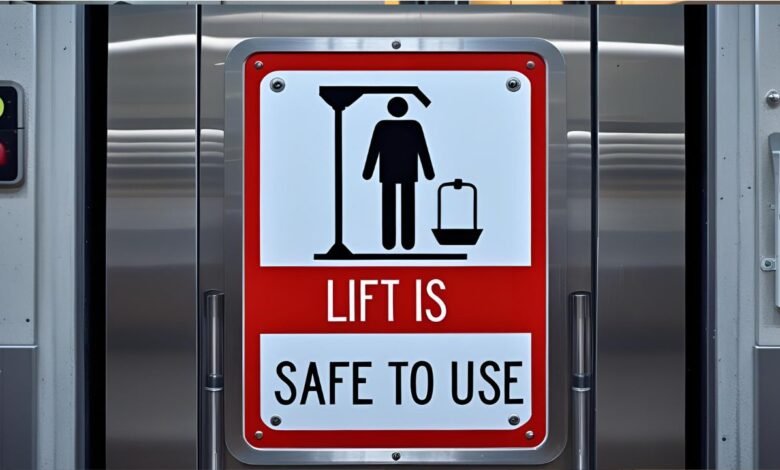Lift Safety Guide For Safe Inspections, Use And Maintenance

Lift safety is the practice of keeping elevators and lifting platforms safe, reliable and easy to use for everyone.
It is about preventing accidents, ensuring proper care, following clear rules and creating a feeling of security for people who depend on lifts every day.
Lift safety covers everything from regular checks and clear instructions for passengers to emergency response when something goes wrong.
When lifts are managed with care, buildings become more accessible, safer and more trusted by the people who live and work in them.
Understanding The Concept Of Lift Safety
Lift safety brings together systems, legal rules and good habits that work together to make vertical travel safe.
It includes correct installation, regular checks, proper care, safe operation and good communication with users.
The goal is to lower risks and give people confidence that lifts are reliable and ready to use.
When these steps are ignored, accidents, breakdowns and fear can quickly follow.
This responsibility is shared between makers, technicians, building managers and the passengers who use them every day.
The Importance Of Lift Safety In Daily Life
Millions of people use lifts daily without thinking about the risks.
Most rides are smooth, but when safety is ignored even a small fault can have serious results.
In different countries there are hundreds of reports every year of people trapped, equipment failures and injuries that could have been avoided.
These events create worry, especially for older people, people with disabilities or children.
Lift safety prevents these problems before they happen and lowers their impact if they do occur.
It also keeps buildings open and easy to use, which is an important part of modern living.
The Role Of Regulations And Standards
Lifts work under clear laws and engineering standards.
In the United States, rules from the Occupational Safety and Health Administration require regular checks, clear signs and emergency steps.
Standards like the ASME A17 series describe in detail how lifts must be built and tested.
In the United Kingdom, the Lifting Operations and Lifting Equipment Regulations known as LOLER require a full check every six months for lifts carrying people.
In Europe, the EN 81 series makes sure that modern lifts meet detailed safety design and testing steps.
These standards cover areas such as door safety edges, braking systems, emergency alarms and rescue access.
Following these rules helps owners and service companies protect lives and lower risk.
How Regular Inspections Make A Difference
Inspection is the heart of lift safety.
Frequent checks find faults before they become dangerous.
Quick visual checks are done monthly, and full technical checks are done every six or twelve months depending on the type of lift.
Inspectors look at cables, brakes, control systems, doors, safety sensors and car alignment.
They keep a record of what they find so repairs can be done fast.
Without these checks, wear and tear builds up silently until something fails.
For this reason, inspection schedules are written into law and must be recorded for everyone’s safety.
Maintenance As A Preventive Approach
Maintenance is more than fixing what is broken.
A good plan is preventive.
Technicians clean, oil, adjust and test parts before they fail.
This includes brakes, doors, motors, sensors and ropes.
When maintenance is done properly, lifts move smoothly, stop at the right level, doors work correctly and alarms work when needed.
Good maintenance makes the equipment last longer and saves money because large breakdowns are rare.
Managers must always work with professional lift service companies to make sure nothing is missed.
Safe Operation And Passenger Awareness
Lift safety also depends on the behavior of passengers.
Safe use reduces risk and keeps the system working well.
This means entering and leaving calmly, not overloading the car, not forcing doors open and using the emergency button if the lift stops.
It also means telling building staff about unusual noises, jerky movement or slow doors so these signs can be checked before they become serious.
Awareness posters inside buildings help people remember how to use lifts correctly.
Load Limits And The Importance Of Signage
Every lift is made to carry a safe amount of weight.
If that limit is crossed, strain is placed on cables and machines, which can lead to failure.
This is why all lifts display the maximum number of people or total weight clearly.
These signs are part of lift safety.
Staying within the limits keeps the lift smooth and prevents damage.
Building operators must make sure these signs are visible, easy to read and kept up to date.
Emergency Systems And Response Planning
Even with good care and use, faults can still happen.
Power cuts, bad weather or technical faults can cause a lift to stop between floors.
This is why emergency systems are built into modern lifts.
These systems include alarm buttons that contact trained helpers, in-car phones or intercoms and emergency lights powered by backup batteries.
Building staff need training to handle an emergency, call rescue teams and calm passengers who may be stuck.
Emergency plans that are clear and practiced prevent panic and keep everyone safe until help arrives.
Common Hazards That Lift Safety Prevents
The most common hazards include trips and falls caused by uneven floor levels, injuries from doors closing without sensors, being trapped during a breakdown and harm to staff who work in lift shafts or machine rooms.
Electric shocks and poor air flow in machine rooms can also be dangerous.
Lift safety steps reduce these hazards one by one.
Checks catch uneven floors early.
Sensors on doors stop them from closing on people.
Rescue training ensures that anyone stuck inside is helped fast.
For staff, lockout steps and safety gear reduce the risk of working in small spaces.
Modern Technology And Its Role In Lift Safety
Modern lifts are getting smarter.
Sensors can now watch lift performance in real time, noticing strange shakes, wrong alignment or overheating.
These systems alert the maintenance team before a failure happens.
Remote monitoring lets engineers check problems from a distance and sometimes fix them without visiting.
Modern upgrades also include features like automatic evacuation to the nearest floor during a power cut and voice guidance to help passengers stay calm.
These improvements add an extra layer of safety.
A Case Of Proactive Lift Safety
In a busy office building, the management added smart monitoring to all lifts.
Within months the system found small brake issues and changes in door speed that people had not noticed.
Technicians fixed these issues before any breakdown happened.
As a result, the building has not had a single entrapment in over two years.
Staff and visitors now feel more confident and safe using the lifts.
This example shows how proactive lift safety creates a better environment.
Training For Staff And Technicians
Lift safety depends on people as much as machines.
People who work with lifts must be well trained.
Technicians learn how to check, test and fix complex systems.
Building staff learn how to test alarms, respond to calls and guide passengers during trouble.
Regular refresher courses make sure skills stay strong.
Training also teaches why following steps and never taking shortcuts is important because even small mistakes can cause serious problems.
Lift Safety For Special Groups
Lift safety is very important for people who rely on it the most.
Older adults, people with disabilities and young children depend on lifts to reach their homes, workplaces and public places.
When lifts fail, these groups can face isolation or harm.
Buildings that care about lift safety also care about inclusion.
Features like large buttons, accessible alarms and voice guidance make sure everyone can use lifts safely.
The Responsibility Of Building Owners And Managers
The main responsibility for lift safety lies with building owners and managers.
They must arrange inspections, keep clear records, work with expert companies and respond fast when a problem is reported.
Delaying repairs or ignoring maintenance creates danger.
Responsible managers treat lift safety as a basic duty, not as a choice.
This attitude follows the law and builds a safe space for all.
How To Create A Culture Of Lift Safety
Lift safety works best when it becomes a normal part of life in a building.
Creating a culture of safety means more than technical checks.
It means encouraging people to report problems, training staff to stay calm, making signs clear and keeping communication open with everyone in the building.
It also means updating safety rules often and adding new systems as technology improves.
Over time this culture builds trust in the lift and in the people responsible for it.
The Future Of Lift Safety
Technology, design and rules will keep improving lift safety in the coming years.
Artificial intelligence will be able to predict when parts will fail with better accuracy.
Better evacuation systems may become standard.
Digital monitoring will become more common, with real time data available to building managers.
Even as these new tools appear, the basics will stay the same.
Clear rules, skilled people, regular checks and a promise to protect passengers will always be the center of lift safety.
Conclusion
Lift safety is an essential part of modern buildings.
It is not only about machines and rules but also about people, trust and confidence.
A good lift safety plan brings together regular inspections, professional maintenance, responsible use, effective emergency planning and a readiness to use new technology.
When all these parts work together, lifts become more than a way to move between floors.
They become safe and reliable.
Whether in an office, a hospital, a shopping mall or a home, lift safety makes sure every ride begins and ends with calm and confidence.




